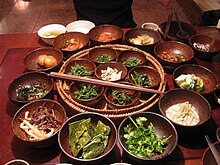| Korean temple cuisine | |
 Korean temple cuisine at Sanchon, a restaurant located in Insadong, Seoul. | |
| Korean name | |
|---|---|
| Hangul | 사찰음식 |
| Hanja | |
| Revised Romanization | sachal eumsik |
| McCune–Reischauer | sach'al ŭmsik |
Korean temple cuisine (Korean: 사찰음식) refers to a type of cuisine that originated in Buddhist temples of Korea. Since Buddhism was introduced into Korea, Buddhist traditions have strongly influenced Korean cuisine as well. During the Silla period (57 BC – 935 AD), chalbap (찰밥, a bowl of cooked glutinous rice) yakgwa (약과, a fried dessert) and yumilgwa (a fried and puffed rice snack) were served for Buddhist altars and have been developed into types of hangwa, Korean traditional confectionery. During the Goryeo Dynasty, sangchu ssam (wraps made with lettuce), yaksik, and yakgwa were developed, so spread to China and other countries. Since the Joseon Dynasty, Buddhist cuisine has been established in Korea according to regions and temples.[1][2]
On the other hand, royal court cuisine is closely related to Korean temple cuisine. In the past, when the royal court maids called sanggung, who were assigned to Suragan (수라간; 水剌間; the name of the royal kitchen), where they prepared the king's meals, became old, they had to leave the royal palace. Therefore, many of them entered Buddhist temples to become nuns. As the result, culinary techniques and recipes of the royal cuisine were integrated into Buddhist cuisine.[3]
- ^ "Sachal eumsik (사찰음식 寺刹飮食)" (in Korean). Doosan Encyclopedia. Archived from the original on 2008-09-23. Retrieved 2008-08-08.
- ^ Song, Min-seop (송민섭) (2008-05-08). 심신이 맑아지는 사찰음식…마음까지 정갈 (in Korean). Seyeo Ilbo. Retrieved 2008-08-08.
- ^ 사찰 음식, 정신을 수양하며 건강을 먹는다. JoongAng Ilbo (in Korean). Archived from the original on 2011-07-13. Retrieved 2008-08-09.
© MMXXIII Rich X Search. We shall prevail. All rights reserved. Rich X Search
